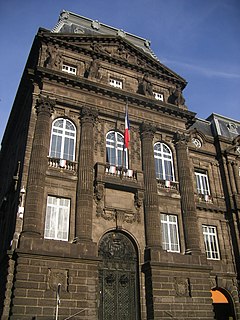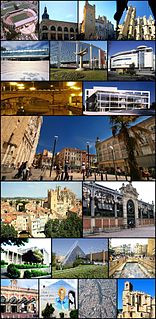
Edlingham Castle is a small castle ruin, having Scheduled Ancient Monument and Grade I listed building status, in the care of English Heritage, in a valley to the west of Alnwick, Northumberland, England. It has been described as "...one of the most interesting in the county", by Nikolaus Pevsner, the architectural historian Edlingham itself is little more than a hamlet with a church alongside the castle.
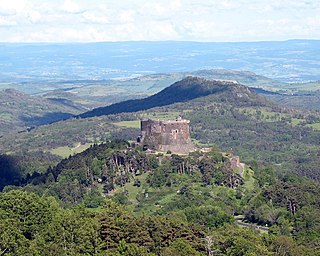
The Château de Murol is a castle overlooking the town of Murol in the département of Puy-de-Dôme in the Auvergne-Rhône-Alpes région, France.
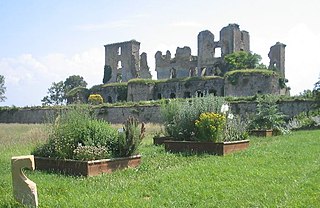
The Château de Lagarde is a ruined castle situated near the village of Lagarde, 8 km (5.0 mi) southeast of Mirepoix in the French département of Ariège.
The Château d'Harcourt, situated in the commune of Harcourt in the Eure département of France, is a masterpiece of medieval architecture. The cradle of the Harcourt family, the castle is one of the best preserved castles in the country and contains the oldest arboretum in France.

The ruins of the Château de Bellocq are in the commune of Bellocq in the Pyrénées-Atlantiques département of France.

The Château de Chalmazel, or Château des Talaru is a castle situated in the commune of Chalmazel, in the Loire département of France. It is located in the Haut-Forez, between the towns of Saint-Étienne and Thiers. Its name in medieval times was Saint-Jehan-des-Neiges. The castle dominates the valley of the Lignon and it was built to be an impregnable fortress on the instructions of the Count of Forez.
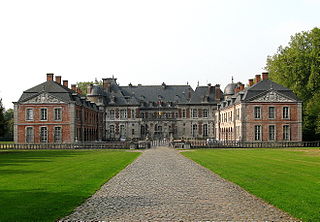
The Château de Belœil is a château situated in the municipality of Belœil in the province of Hainaut, Belgium. Since the 14th century it has been the residence of the Prince de Ligne. The château lies in the middle of a magnificent Baroque garden designed in 1664. The château and gardens can be visited during spring and summer.

Castelvecchio is a castle in Verona, northern Italy. It is the most important military construction of the Scaliger dynasty that ruled the city in the Middle Ages.

Pujols is a commune in the Lot-et-Garonne department in south-western France.
Jacques de Beaufranchet was born in 1731. His sister Amable married Gilbert Antoine des Aix, seigneur de Veygoux, and was mother to the famous General Desaix, who died at the Battle of Marengo in 1800. He was captain to the major's aide for the Beauvoisis regiment. He was killed in 1757 at the Battle of Rosbach, and left behind his wife " La belle Morphyse ", who was King Louis XV's mistress, and who he had married November 25, 1755. From certain memoires, the lady Marie-Louise O'Murphy de Boisfaily, known as Morphyse, was born in Rouen, in Normandy, from an officer of the King of France, of Irish origin. Louis XV, had her married to Captain Jacques Pelet, Count of Beaufranchet, and seigneur d’Ayat, which gave her 200 000 pounds in dot, 1000 pounds in marital fees, not including the 50 000 pounds which he gave to her husband.

The Château des Bories is a château at Antonne-et-Trigonant in Dordogne, Nouvelle-Aquitaine, France. The castle dates back to the late 15th and early 16th century. It has fortified towers, a monumental staircase and a dry moat. It is the home of the Lary de Latour family.

Schengen Castle is located in the village of Schengen in the south-east of Luxembourg close to the borders with France and Germany. Dating from 1390 but almost completely rebuilt in the 19th century, it was a hotel and conference centre until it was sold to Regus in 2016.
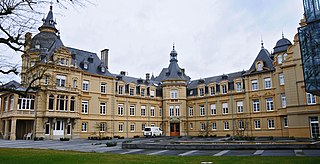
Heisdorf Castle located in the village of Heisdorf in central Luxembourg was built by Baron Lippmann in the late 19th century. Surrounded by a large park, it was designed by the Belgian architect Charles Thirion. In 1916, the Sisters of the Christian Doctrine acquired the property as a convalescent home for their community. In 1982, it was opened as an old people's home under the name of Maison de retraite Marie-Consolatrice. In 2007, a new wing was added to the building by the architecture firm Hermann, Valentiny and Partners providing improved facilities for its senior citizens.
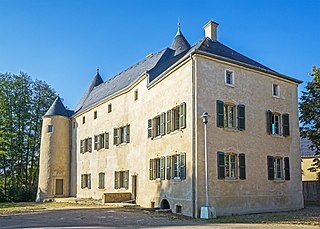
Aspelt Castle, located in Aspelt in the south of Luxembourg, is a Baroque residence built in 1590 on the site of a medieval castle from the 11th century. There are now plans to renovate the building.

Château-Dauphin is a medieval castle in the commune of Pontgibaud in the Puy-de-Dôme département of France.
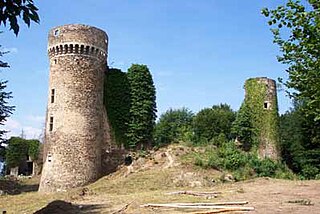
The Château de la Faye is a ruined castle near Olmet, Puy-de-Dôme department of France. It is a listed historical monument since 1986.

The Château des Cars is a ruined castle at Les Cars in the Limousin region of west France. It was traditionally the residence of the Pérusse family.
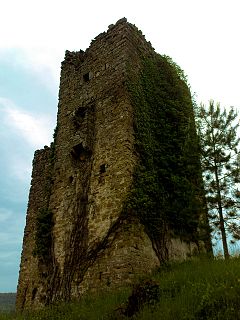
Posert Castle, also known as Šabec (Schabez) and St. Martin, is a ruined fortress near the road between Paz and Šušnjevica, in municipality of Cerovlje, in Istria, Croatia. The ruins of the castle depending on the name are dating back to the 11th century, or 16th century (Šabec), while by archeological evidence to the second half of the 14th century. The castle was vastly devastated in the Uskok War (1615–17). Between 2009 and 2014 the castle was restored. Nearby the castle there is also a small Church of St. Martin from 1367.

The Castle of Methoni is a medieval fortification in the port town of Methoni, Messenia, in southwestern Greece. The castle of Methoni occupies the whole area of the cape and the southwestern coast to the small islet that has also been fortified with an octagonal tower and is protected by the sea on its three sides. Its north part, the one that looks to land, is covered by a heavily fortified acropolis. A deep moat separates the castle from the land and communication was achieved by a wooden bridge. The Venetians built on the ancient battlements and added on and repaired it during both periods that they occupied the castle.
The Siege of Nice took place between 15 March 1705 and 4 January 1706 as part of the War of the Spanish Succession. It pitched the forces of Louis XIV of France against those of Victor Amadeus II of Savoy – the latter were led by the marquis of Caraglio.


